Polymer-Coated Nanoparticles for Therapeutic and Diagnostic Non-10B Enriched Polymer-Coated Boron Carbon Oxynitride (BCNO) Nanoparticles as Potent BNCT Drug
Abstract
:1. Introduction
2. Materials and Methods
2.1. Chemicals and Instrument
2.2. Synthesis of BCNO Nanoparticle
2.3. Functionalization of the BCNO Nanoparticle with PEI and PEG Ligands
2.4. Functionalization of the BCNO Nanoparticle with PSMA-CR
2.5. Synthesis of L-(4-10Borophenyl)alanine Fructose Complex (BPA-F)
2.6. Cell Viability Assay
2.7. In Vitro Cell Uptake
2.8. Thermal Neutron Irradiation Experiments
3. Results and Discussion
3.1. Synthesis and Characterization of Polymer-Coated BCNO
3.2. Cytotoxicity Study of the BCNO, PEI@BCNO, and PEG@BCNO
3.3. In-Vitro Boron Neutron Capture Therapy Using Polymer-Coated BCNO Nanoparticles
4. Conclusions
Supplementary Materials
Author Contributions
Funding
Data Availability Statement
Conflicts of Interest
References
- Dymova, M.A.; Taskaev, S.Y.; Richter, V.A.; Kuligina, E.V. Boron Neutron Capture Therapy: Current Status and Future Perspectives. Cancer Commun. 2020, 40, 406–421. [Google Scholar] [CrossRef]
- Nedunchezhian, K. Boron Neutron Capture Therapy––A Literature Review. J. Clin. Diagn. Res. 2016, 10, ZE01–ZE04. [Google Scholar] [CrossRef] [PubMed]
- Barth, R.F.; Goodman, J.H.; Gupta, N.; Yang, W. Boron Neutron Capture Therapy of Brain Tumors: An Emerging Therapeutic Modality. Neurosurgery 2018, 18, 433–450. [Google Scholar] [CrossRef] [PubMed]
- Wittig, A.; Malago, M.; Collette, L.; Huiskamp, R.; Bührmann, S.; Nievaart, V.; Kaiser, G.M.; Jöckel, K.-H.; Schmid, K.W.; Ortmann, U.; et al. Uptake of Two 10B-Compounds in Liver Metastases of Colorectal Adenocarcinoma for Extracorporeal Irradiation with Boron Neutron Capture Therapy (EORTC Trial 11001). Int. J. Cancer 2007, 122, 1164–1171. [Google Scholar] [CrossRef] [PubMed]
- Menéndez, P.R.; Roth, B.M.C.; Pereira, M.D.; Casal, M.R.; González, S.J.; Feld, D.B.; Santa Cruz, G.A.; Kessler, J.; Longhino, J.; Blaumann, H.; et al. BNCT for Skin Melanoma in Extremities: Updated Argentine Clinical Results. Appl. Radiat. Isot. 2009, 67, S50–S53. [Google Scholar] [CrossRef] [PubMed]
- Yanagie, H.; Higashi, S.; Seguchi, K.; Ikushima, I.; Fujihara, M.; Nonaka, Y.; Oyama, K.; Maruyama, S.; Hatae, R.; Suzuki, M.; et al. Pilot Clinical Study of Boron Neutron Capture Therapy for Recurrent Hepatic Cancer Involving the Intra-Arterial Injection of a 10BSH-Containing WOW Emulsion. Appl. Radiat. Isot. 2014, 88, 32–37. [Google Scholar] [CrossRef]
- Slatkin, D.N. A History of Boron Neutron Capture Therapy of Brain Tumours: Postulation of a Brain Radiation Dose Tolerance Limit. Brain 1991, 114, 1609–1629. [Google Scholar] [CrossRef] [PubMed]
- Fuwa, N.; Suzuki, M.; Sakurai, Y.; Nagata, K.; Kinashi, Y.; Masunaga, S.; Maruhashi, A.; Imahori, Y.; Kodaira, T.; Tachibana, H.; et al. Treatment Results of Boron Neutron Capture Therapy Using Intra-Arterial Administration of Boron Compounds for Recurrent Head and Neck Cancer. Br. J. Radiol. 2008, 81, 749–752. [Google Scholar] [CrossRef] [PubMed]
- Hung, Y.-H.; Lin, Y.-C.; Lin, Y.-T.; Shih, G.-W.; Liao, J.-W.; Chen, K.-S.; Liu, H.-M.; Chen, Y.-W.; Chuang, Y.-J.; Yang, C.-M.; et al. Therapeutic Efficacy and Radiobiological Effects of Boric Acid-Mediated BNCT in a VX2 Multifocal Liver Tumor-Bearing Rabbit Model. Anticancer Res. 2019, 39, 5495–5504. [Google Scholar] [CrossRef] [PubMed]
- Kageji, T.; Otersen, B.; Gabel, D.; Huiskamp, R.; Nakagawa, Y.; Matsumoto, K. Interaction of Mercaptoundecahydrododecaborate ŽBSH/with Phosphatidylcholine: Relevance to Boron Neutron Capture Therapy. Biochim. Biophys. Acta Lipids Lipid Metab. 1998, 1391, 377–383. [Google Scholar] [CrossRef]
- Kankaanranta, L.; Seppälä, T.; Koivunoro, H.; Saarilahti, K.; Atula, T.; Collan, J.; Salli, E.; Kortesniemi, M.; Uusi-Simola, J.; Välimäki, P.; et al. Boron Neutron Capture Therapy in the Treatment of Locally Recurred Head-and-Neck Cancer: Final Analysis of a Phase I/II Trial. Int. J. Radiat. Oncol. 2012, 82, e67–e75. [Google Scholar] [CrossRef] [PubMed]
- Wang, L.W.; Wang, S.J.; Chu, P.Y.; Ho, C.Y.; Jiang, S.H.; Liu, Y.W.H.; Liu, Y.H.; Liu, H.M.; Peir, J.J.; Chou, F.I.; et al. BNCT for Locally Recurrent Head and Neck Cancer: Preliminary Clinical Experience from a Phase I/II Trial at Tsing Hua Open-Pool Reactor. Appl. Radiat. Isot. 2011, 69, 1803–1806. [Google Scholar] [CrossRef]
- Hu, K.; Yang, Z.; Zhang, L.; Xie, L.; Wang, L.; Xu, H.; Josephson, L.; Liang, S.H.; Zhang, M.-R. Boron Agents for Neutron Capture Therapy. Coord. Chem. Rev. 2020, 405, 213139. [Google Scholar] [CrossRef]
- Fuentes, I.; García-Mendiola, T.; Sato, S.; Pita, M.; Nakamura, H.; Lorenzo, E.; Teixidor, F.; Marques, F.; Viñas, C. Metallacarboranes on the Road to Anticancer Therapies: Cellular Uptake, DNA Interaction, and Biological Evaluation of Cobaltabisdicarbollide [COSAN]. Chemistry 2018, 24, 17239–17254. [Google Scholar] [CrossRef]
- Kawai, K.; Nishimura, K.; Okada, S.; Sato, S.; Suzuki, M.; Takata, T.; Nakamura, H. Cyclic RGD-Functionalized Closo-Dodecaborate Albumin Conjugates as Integrin Targeting Boron Carriers for Neutron Capture Therapy. Mol. Pharm. 2020, 17, 3740–3747. [Google Scholar] [CrossRef]
- Oleshkevich, E.; Morancho, A.; Saha, A.; Galenkamp, K.M.O.; Grayston, A.; Crich, S.G.; Alberti, D.; Protti, N.; Comella, J.X.; Teixidor, F.; et al. Combining Magnetic Nanoparticles and Icosahedral Boron Clusters in Biocompatible Inorganic Nanohybrids for Cancer Therapy. Nanomed. Nanotechnol. Biol. Med. 2019, 20, 101986. [Google Scholar] [CrossRef] [PubMed]
- Ferrer-Ugalde, A.; Sandoval, S.; Pulagam, K.R.; Muñoz-Juan, A.; Laromaine, A.; Llop, J.; Tobias, G.; Núñez, R. Radiolabeled Cobaltabis(Dicarbollide) Anion–Graphene Oxide Nanocomposites for In Vivo Bioimaging and Boron Delivery. ACS Appl. Nano Mater. 2021, 4, 1613–1625. [Google Scholar] [CrossRef]
- Azab, A.-K.; Srebnik, M.; Doviner, V.; Rubinstein, A. Targeting Normal and Neoplastic Tissues in the Rat Jejunum and Colon with Boronated, Cationic Acrylamide Copolymers. J. Control. Release 2005, 106, 14–25. [Google Scholar] [CrossRef]
- Ignatius, A.A.; Claes, L. In Vitro Biocompatibility of Bioresorbable Polymers: Poly(~, DL-Lactide) and Poly(L-Lactide-Co-Glycolide). Biomaterials 1996, 17, 9. [Google Scholar] [CrossRef]
- Takeuchi, I.; Nomura, K.; Makino, K. Hydrophobic Boron Compound-Loaded Poly(l-Lactide-Co-Glycolide) Nanoparticles for Boron Neutron Capture Therapy. Colloids Surf. B Biointerfaces 2017, 159, 360–365. [Google Scholar] [CrossRef] [PubMed]
- Takeuchi, I.; Tomoda, K.; Hamano, A.; Makino, K. Effects of Physicochemical Properties of Poly(Lactide-Co-Glycolide) on Drug Release Behavior of Hydrophobic Drug-Loaded Nanoparticles. Colloids Surf. Physicochem. Eng. Asp. 2017, 520, 771–778. [Google Scholar] [CrossRef]
- Xiong, H.; Zhou, D.; Qi, Y.; Zhang, Z.; Xie, Z.; Chen, X.; Jing, X.; Meng, F.; Huang, Y. Doxorubicin-Loaded Carborane-Conjugated Polymeric Nanoparticles as Delivery System for Combination Cancer Therapy. Biomacromolecules 2015, 16, 3980–3988. [Google Scholar] [CrossRef]
- Cai, J.; Soloway, A.H.; Barth, R.F.; Adams, D.M.; Hariharan, J.R.; Wyzlic, I.M.; Radcliffe, K. Boron-Containing Polyamines as DNA Targeting Agents for Neutron Capture Therapy of Brain Tumors: Synthesis and Biological Evaluation. J. Med. Chem. 1997, 40, 3887–3896. [Google Scholar] [CrossRef]
- Liko, F.; Hindré, F.; Fernandez-Megia, E. Dendrimers as Innovative Radiopharmaceuticals in Cancer Radionanotherapy. Biomacromolecules 2016, 17, 3103–3114. [Google Scholar] [CrossRef]
- Parrott, M.C.; Marchington, E.B.; Valliant, J.F.; Adronov, A. Synthesis and Properties of Carborane-Functionalized Aliphatic Polyester Dendrimers. J. Am. Chem. Soc. 2005, 127, 12081–12089. [Google Scholar] [CrossRef] [PubMed]
- Shukla, S.; Wu, G.; Chatterjee, M.; Yang, W.; Sekido, M.; Diop, L.A.; Müller, R.; Sudimack, J.J.; Lee, R.J.; Barth, R.F.; et al. Synthesis and Biological Evaluation of Folate Receptor-Targeted Boronated PAMAM Dendrimers as Potential Agents for Neutron Capture Therapy. Bioconjug. Chem. 2003, 14, 158–167. [Google Scholar] [CrossRef] [PubMed]
- Wolinsky, J.; Grinstaff, M. Therapeutic and Diagnostic Applications of Dendrimers for Cancer Treatment. Adv. Drug Deliv. Rev. 2008, 60, 1037–1055. [Google Scholar] [CrossRef] [PubMed]
- Altieri, S.; Balzi, M.; Bortolussi, S.; Bruschi, P.; Ciani, L.; Clerici, A.M.; Faraoni, P.; Ferrari, C.; Gadan, M.A.; Panza, L.; et al. Carborane Derivatives Loaded into Liposomes as Efficient Delivery Systems for Boron Neutron Capture Therapy. J. Med. Chem. 2009, 52, 7829–7835. [Google Scholar] [CrossRef]
- Fang, J.; Nakamura, H.; Maeda, H. The EPR Effect: Unique Features of Tumor Blood Vessels for Drug Delivery, Factors Involved, and Limitations and Augmentation of the Effect. Adv. Drug Deliv. Rev. 2011, 63, 136–151. [Google Scholar] [CrossRef]
- Feakes, D.A.; Shelly, K.; Knobler, C.B.; Hawthorne, M.F. Na3[B20H17NH3]: Synthesis and Liposomal Delivery to Murine Tumors. Proc. Natl. Acad. Sci. USA 1994, 91, 3029–3033. [Google Scholar] [CrossRef] [Green Version]
- Feakes, D.A.; Shelly, K.; Hawthorne, M.F. Selective Boron Delivery to Murine Tumors by Lipophilic Species Incorporated in the Membranes of Unilamellar Liposomes. Proc. Natl. Acad. Sci. USA 1995, 92, 1367–1370. [Google Scholar] [CrossRef] [Green Version]
- Feng, B.; Tomizawa, K.; Michiue, H.; Miyatake, S.; Han, X.-J.; Fujimura, A.; Seno, M.; Kirihata, M.; Matsui, H. Delivery of Sodium Borocaptate to Glioma Cells Using Immunoliposome Conjugated with Anti-EGFR Antibodies by ZZ-His. Biomaterials 2009, 30, 1746–1755. [Google Scholar] [CrossRef]
- Malam, Y.; Loizidou, M.; Seifalian, A.M. Liposomes and Nanoparticles: Nanosized Vehicles for Drug Delivery in Cancer. Trends Pharmacol. Sci. 2009, 30, 592–599. [Google Scholar] [CrossRef]
- Shelly, K.; Feakes, D.A.; Hawthorne, M.F.; Schmidt, P.G.; Krisch, T.A.; Bauer, W.F. Model Studies Directed toward the Boron Neutron-Capture Therapy of Cancer: Boron Delivery to Murine Tumors with Liposomes. Proc. Natl. Acad. Sci. USA 1992, 89, 9039–9043. [Google Scholar] [CrossRef] [PubMed] [Green Version]
- Ueda, M.; Ashizawa, K.; Sugikawa, K.; Koumoto, K.; Nagasaki, T.; Ikeda, A. Lipid-Membrane-Incorporated Arylboronate Esters as Agents for Boron Neutron Capture Therapy. Org. Biomol. Chem. 2017, 15, 1565–1569. [Google Scholar] [CrossRef] [Green Version]
- Gedda, L.; Olsson, P.; Pontén, J.; Carlsson, J. Development and in Vitro Studies of Epidermal Growth Factor−Dextran Conjugates for Boron Neutron Capture Therapy. Bioconjug. Chem. 1996, 7, 584–591. [Google Scholar] [CrossRef] [PubMed]
- Holmberg, A.; Meurling, L. Preparation of Sulfhydrylborane-Dextran Conjugates for Boron Neutron Capture Therapy. Bioconjug. Chem. 1993, 4, 570–573. [Google Scholar] [CrossRef] [PubMed]
- Sumitani, S.; Nagasaki, Y. Boron Neutron Capture Therapy Assisted by Boron-Conjugated Nanoparticles. Polym. J. 2012, 44, 522–530. [Google Scholar] [CrossRef] [Green Version]
- Chen, J.; Yang, Q.; Liu, M.; Lin, M.; Wang, T.; Zhang, Z.; Zhong, X.; Guo, N.; Lu, Y.; Xu, J.; et al. Remarkable Boron Delivery of IRGD-Modified Polymeric Nanoparticles For Boron Neutron Capture Therapy. Int. J. Nanomed. 2019, 14, 8161–8177. [Google Scholar] [CrossRef] [Green Version]
- Liu, J.; Ai, X.; Zhang, H.; Zhuo, W.; Mi, P. Polymeric Micelles with Endosome Escape and Redox-Responsive Functions for Enhanced Intracellular Drug Delivery. J. Biomed. Nanotechnol. 2019, 15, 373–381. [Google Scholar] [CrossRef] [PubMed]
- Petersen, M.S.; Petersen, C.C.; Agger, R.; Sutmuller, M.; Jensen, M.R.; Sørensen, P.G.; Mortensen, M.W.; Hansen, T.; Bjørnholm, T.; Gundersen, H.J.; et al. Boron Nanoparticles Inhibit Tumour Growth by Boron Neutron Capture Therapy in the Murine B16-OVA Model. Anticancer Res. 2008, 28, 571–576. [Google Scholar] [PubMed]
- Kuthala, N.; Vankayala, R.; Li, Y.-N.; Chiang, C.-S.; Hwang, K.C. Engineering Novel Targeted Boron-10-Enriched Theranostic Nanomedicine to Combat against Murine Brain Tumors via MR Imaging-Guided Boron Neutron Capture Therapy. Adv. Mater. 2017, 29, 1700850. [Google Scholar] [CrossRef] [PubMed]
- Ferreira, T.H.; Miranda, M.C.; Rocha, Z.; Leal, A.S.; Gomes, D.A.; Sousa, E.M.B. An Assessment of the Potential Use of BNNTs for Boron Neutron Capture Therapy. Nanomaterials 2017, 7, 82. [Google Scholar] [CrossRef] [PubMed] [Green Version]
- Horváth, L.; Magrez, A.; Golberg, D.; Zhi, C.; Bando, Y.; Smajda, R.; Horváth, E.; Forró, L.; Schwaller, B. In Vitro Investigation of the Cellular Toxicity of Boron Nitride Nanotubes. ACS Nano 2011, 5, 3800–3810. [Google Scholar] [CrossRef] [PubMed] [Green Version]
- Lee, C.H.; Drelich, J.; Yap, Y.K. Superhydrophobicity of Boron Nitride Nanotubes Grown on Silicon Substrates. Langmuir 2009, 25, 4853–4860. [Google Scholar] [CrossRef] [PubMed]
- Pakdel, A.; Zhi, C.; Bando, Y.; Nakayama, T.; Golberg, D. Boron Nitride Nanosheet Coatings with Controllable Water Repellency. ACS Nano 2011, 5, 6507–6515. [Google Scholar] [CrossRef] [PubMed]
- Yu, J.; Qin, L.; Hao, Y.; Kuang, S.; Bai, X.; Chong, Y.-M.; Zhang, W.; Wang, E. Vertically Aligned Boron Nitride Nanosheets: Chemical Vapor Synthesis, Ultraviolet Light Emission, and Superhydrophobicity. ACS Nano 2010, 4, 414–422. [Google Scholar] [CrossRef]
- Nakamura, H.; Koganei, H.; Miyoshi, T.; Sakurai, Y.; Ono, K.; Suzuki, M. Antitumor Effect of Boron Nitride Nanotubes in Combination with Thermal Neutron Irradiation on BNCT. Bioorg. Med. Chem. Lett. 2015, 25, 172–174. [Google Scholar] [CrossRef]
- Singh, B.; Kaur, G.; Singh, P.; Singh, K.; Kumar, B.; Vij, A.; Kumar, M.; Bala, R.; Meena, R.; Singh, A.; et al. Nanostructured Boron Nitride With High Water Dispersibility For Boron Neutron Capture Therapy. Sci. Rep. 2016, 6, 35535. [Google Scholar] [CrossRef] [Green Version]
- Mateti, S.; Wong, C.S.; Liu, Z.; Yang, W.; Li, Y.; Li, L.H.; Chen, Y. Biocompatibility of Boron Nitride Nanosheets. Nano Res. 2018, 11, 334–342. [Google Scholar] [CrossRef]
- Chen, T.; Zhang, Q.; Xie, Z.; Tan, C.; Chen, P.; Zeng, Y.; Wang, F.; Liu, H.; Liu, Y.; Liu, G.; et al. Carbon Nitride Modified Hexagonal Boron Nitride Interface as Highly Efficient Blue LED Light-Driven Photocatalyst. Appl. Catal. B Environ. 2018, 238, 410–421. [Google Scholar] [CrossRef]
- Dwivedi, J.; Kumar, P.; Kedawat, G.; Gupta, B. K New Emerging Rare-Earth Free Yellow Emitting 2D BCNO Nanophosphor for White Light Emitting Diodes. New J. Chem. 2015, 39, 5161–5170. [Google Scholar] [CrossRef] [Green Version]
- Fang, S.; Li, G.; Zhao, M.; Zhang, Y.; Yang, L.; Li, L. Non-Rare Earth Containing BCNO Phosphors: Chemical Activation for LED Application. J. Lumin. 2017, 192, 428–435. [Google Scholar] [CrossRef]
- Ogi, T.; Kaihatsu, Y.; Iskandar, F.; Wang, W.-N.; Okuyama, K. Facile Synthesis of New Full-Color-Emitting BCNO Phosphors with High Quantum Efficiency. Adv. Mater. 2008, 20, 3235–3238. [Google Scholar] [CrossRef]
- Zhang, X.; Lu, Z.; Liu, H.; Lin, J.; Xu, X.; Meng, F.; Zhao, J.; Tang, C. Blue Emitting BCNO Phosphors with High Quantum Yields. J. Mater. Chem. C 2015, 3, 3311–3317. [Google Scholar] [CrossRef]
- Jia, X.; Li, L.; Yu, J.; Gao, X.; Yang, X.; Lu, Z.; Zhang, X.; Liu, H. Facile Synthesis of BCNO Quantum Dots with Applications for Ion Detection, Chemosensor and Fingerprint Identification. Spectrochim. Acta Part A Mol. Biomol. Spectrosc. 2018, 203, 214–221. [Google Scholar] [CrossRef] [PubMed]
- Kanodarwala, F.K.; Moret, S.; Spindler, X.; Lennard, C.; Roux, C. Nanoparticles Used for Fingermark Detection—A Comprehensive Review. Wiley Interdiscip. Rev. Forensic Sci. 2019, 1, e1341. [Google Scholar] [CrossRef]
- Ren, M.; Han, W.; Bai, Y.; Ge, C.; He, L.; Zhang, X. Melamine Sponge-Assisted Synthesis of Porous BCNO Phosphor with Yellow-Green Luminescence for Cr6+ Detection. Mater. Chem. Phys. 2020, 244, 122673. [Google Scholar] [CrossRef]
- Wu, Z.; Zhou, Y.; Huang, H.; Su, Z.; Chen, S.; Rong, M. BCNO QDs and ROS Synergistic Oxidation Effect on Fluorescence Enhancement Sensing of Tetracycline. Sens. Actuators B Chem. 2021, 332, 129530. [Google Scholar] [CrossRef]
- Gupta, B.K.; Kumar, P.; Kedawat, G.; Kanika, K.; Vithayathil, S.A.; Gangwar, A.K.; Singh, S.; Kashyap, P.K.; Lahon, R.; Singh, V.N.; et al. Tunable Luminescence from Two Dimensional BCNO Nanophosphor for High-Contrast Cellular Imaging. RSC Adv. 2017, 7, 41486–41494. [Google Scholar] [CrossRef] [Green Version]
- Xue, Q.; Zhang, H.; Zhu, M.; Wang, Z.; Pei, Z.; Huang, Y.; Huang, Y.; Song, X.; Zeng, H.; Zhi, C. Hydrothermal Synthesis of Blue-Fluorescent Monolayer BN and BCNO Quantum Dots for Bio-Imaging Probes. RSC Adv. 2016, 6, 79090–79094. [Google Scholar] [CrossRef]
- Dong, G.; Liu, X.; Xiao, X.; Zhang, Q.; Lin, G.; Ma, Z.; Chen, D.; Qiu, J. Tunable Emission of BCNO Nanoparticle-Embedded Polymer Electrospun Nanofibers. Electrochem. Solid State Lett. 2009, 12, K53. [Google Scholar] [CrossRef]
- Suryamas, A.B.; Munir, M.M.; Ogi, T.; Khairurrijal; Okuyama, K. Intense Green and Yellow Emissions from Electrospun BCNO Phosphor Nanofibers. J. Mater. Chem. 2011, 21, 12629–12631. [Google Scholar] [CrossRef]
- Kim, A.; Suzuki, M.; Matsumoto, Y.; Fukumitsu, N.; Nagasaki, Y. Non-Isotope Enriched Phenylboronic Acid-Decorated Dual-Functional Nano-Assembles for an Actively Targeting BNCT Drug. Biomaterials 2021, 268, 120551. [Google Scholar] [CrossRef] [PubMed]
- Van Wijk, J.; Van Deventer, N.; Harmzen, E.; Meuldijk, J.; Klumperman, B. Formation of Hybrid Poly(Styrene-Co-Maleic Anhydride)–Silica Microcapsules. J. Mater. Chem. B 2014, 2, 4826–4835. [Google Scholar] [CrossRef] [Green Version]
- Sun, J.; Ling, P.; Gao, F. A Mitochondria-Targeted Ratiometric Biosensor for PH Monitoring and Imaging in Living Cells with Congo-Red-Functionalized Dual-Emission Semiconducting Polymer Dots. Anal. Chem. 2017, 89, 11703–11710. [Google Scholar] [CrossRef]
- Wang, W.-N.; Ogi, T.; Kaihatsu, Y.; Iskandar, F.; Okuyama, K. Novel Rare-Earth-Free Tunable-Color-Emitting BCNO Phosphors. J. Mater. Chem. 2011, 21, 5183. [Google Scholar] [CrossRef]
- Tang, C.; Bando, Y.; Zhi, C.; Golberg, D. Boron–Oxygen Luminescence Centres in Boron–Nitrogen Systems. Chem. Commun. 2007, 44, 4599–4601. [Google Scholar] [CrossRef]
- Srivastava, I.; Khamo, J.S.; Pandit, S.; Fathi, P.; Huang, X.; Cao, A.; Haasch, R.T.; Nie, S.; Zhang, K.; Pan, D. Influence of Electron Acceptor and Electron Donor on the Photophysical Properties of Carbon Dots: A Comparative Investigation at the Bulk-State and Single-Particle Level. Adv. Funct. Mater. 2019, 29, 1902466. [Google Scholar] [CrossRef]
- Yang, S.; Sun, J.; Li, X.; Zhou, W.; Wang, Z.; He, P.; Ding, G.; Xie, X.; Kang, Z.; Jiang, M. Large-Scale Fabrication of Heavy Doped Carbon Quantum Dots with Tunable-Photoluminescence and Sensitive Fluorescence Detection. J. Mater. Chem. A 2014, 2, 8660. [Google Scholar] [CrossRef]
- Li, L.; Dong, T. Photoluminescence Tuning in Carbon Dots: Surface Passivation or/and Functionalization, Heteroatom Doping. J. Mater. Chem. C 2018, 6, 7944–7970. [Google Scholar] [CrossRef]
- Geick, R.; Perry, C.H.; Rupprecht, G. Normal Modes in Hexagonal Boron Nitride. Phys. Rev. 1966, 146, 543–547. [Google Scholar] [CrossRef]
- Lu, F.; Zhang, X.; Lu, Z.; Xu, X.; Tang, C. Effects of Annealing Temperature and Ambient Atmosphere on the Structure and Photoluminescence of BCNO Phosphors. J. Lumin. 2013, 143, 343–348. [Google Scholar] [CrossRef]
- Huang, K.; Liang, L.; Chai, S.; Tumuluri, U.; Li, M.; Wu, Z.; Sumpter, B.G.; Dai, S. Aminopolymer Functionalization of Boron Nitride Nanosheets for Highly Efficient Capture of Carbon Dioxide. J. Mater. Chem. A 2017, 5, 16241–16248. [Google Scholar] [CrossRef]
- Wang, Y.; Tong, L.; You, Y.; Tu, L.; Zhou, M.; Liu, X. Polyethylenimine Assisted Bio-Inspired Surface Functionalization of Hexagonal Boron Nitride for Enhancing the Crystallization and the Properties of Poly(Arylene Ether Nitrile). Nanomaterials 2019, 9, 760. [Google Scholar] [CrossRef] [PubMed] [Green Version]
- Chen, T.; Zheng, S.; Li, X.; Zhang, Y.; Wong, Y.-S. PEG-nanolized ultrasmall selenium nanoparticles overcome drug resistance in hepatocellular carcinoma HepG2 cells through induction of mitochondria dysfunction. Int. J. Nanomed. 2012, 7, 3939–3949. [Google Scholar] [CrossRef] [PubMed] [Green Version]
- Chien, L.C.; Chiang, C.W.; Lao, C.C.; Lin, Y.-I.; Lin, H.-W.; Keng, P.Y. Boron Carbon Oxynitride as a Novel Metal-Free Photocatalyst. 2021, in press. [Google Scholar]
- Wu, Y.; He, Y.; Zhou, T.; Chen, C.; Zhong, F.; Xia, Y.; Xie, P.; Zhang, C. Synergistic Functionalization of H-BN by Mechanical Exfoliation and PEI Chemical Modification for Enhancing the Corrosion Resistance of Waterborne Epoxy Coating. Prog. Org. Coat. 2020, 142, 105541. [Google Scholar] [CrossRef]
- Akin, M.; Bongartz, R.; Walter, J.G.; Demirkol, D.O.; Stahl, F.; Timur, S.; Scheper, T. PAMAM-Functionalized Water Soluble Quantum Dots for Cancer Cell Targeting. J. Mater. Chem. 2012, 22, 11529. [Google Scholar] [CrossRef] [Green Version]
- Cotoruelo, L.M.; Marqués, M.D.; Díaz, F.J.; Rodríguez-Mirasol, J.; Rodríguez, J.J.; Cordero, T. Equilibrium and Kinetic Study of Congo Red Adsorption onto Lignin-Based Activated Carbons. Transp. Porous Media 2010, 83, 573–590. [Google Scholar] [CrossRef]
- Kashyout, A.-H.; Soliman, H.; Nabil, M.; Bishara, A. Impact of Congo Red Dye in Nano-Porous Silicon as PH-Sensor. Sens. Actuators B Chem. 2015, 216, 279–285. [Google Scholar] [CrossRef]
- Espargaró, A.; Llabrés, S.; Saupe, S.J.; Curutchet, C.; Luque, F.J.; Sabaté, R. On the Binding of Congo Red to Amyloid Fibrils. Angew. Chem. Int. Ed. 2020, 59, 8104–8107. [Google Scholar] [CrossRef]
- Jagusiak, A.; Konieczny, L.; Krol, M.; Marszalek, P.; Piekarska, B.; Piwowar, P.; Roterman, I.; Rybarska, J.; Stopa, B.; Zemanek, G. Intramolecular Immunological Signal Hypothesis Revived-Structural Background of Signalling Revealed by Using Congo Red as a Specific Tool. Mini-Rev. Med. Chem. 2015, 14, 1104–1113. [Google Scholar] [CrossRef] [Green Version]
- Klunk, W. Chrysamine-G Binding to Alzheimer and Control Brain: Autopsy Study of a New Amyloid Probe. Neurobiol. Aging 1995, 16, 541–548. [Google Scholar] [CrossRef]
- Yakupova, E.I.; Bobyleva, L.G.; Vikhlyantsev, I.M.; Bobylev, A.G. Congo Red and Amyloids: History and Relationship. Biosci. Rep. 2019, 39, BSR20181415. [Google Scholar] [CrossRef] [PubMed] [Green Version]
- Zemanek, G.; Jagusiak, A.; Chłopaś, K.; Piekarska, B.; Stopa, B. Congo Red Fluorescence upon Binding to Macromolecules––A Possible Explanation for the Enhanced Intensity. Bio-Algorithms Med-Syst. 2017, 13, 69–78. [Google Scholar] [CrossRef]
- AL-Thabaiti, S.A.; Aazam, E.S.; Khan, Z.; Bashir, O. Aggregation of Congo Red with Surfactants and Ag-Nanoparticles in an Aqueous Solution. Spectrochim. Acta. A Mol. Biomol. Spectrosc. 2016, 156, 28–35. [Google Scholar] [CrossRef]
- Litefti, K.; Freire, M.S.; Stitou, M.; González-Álvarez, J. Adsorption of an Anionic Dye (Congo Red) from Aqueous Solutions by Pine Bark. Sci. Rep. 2019, 9, 16530. [Google Scholar] [CrossRef] [Green Version]
- Costa, A.L.; Gomes, A.C.; Lopes, A.D.; Da Silva, J.P.; Pillinger, M.; Gonçalves, I.S.; Seixas de Melo, J.S. Evaluation of the Supramolecular Interaction of Congo Red with Cucurbiturils Using Mass Spectrometry and Spectroscopic Methods. New J. Chem. 2020, 44, 2587–2596. [Google Scholar] [CrossRef]
- Wang, S.-C.; Hong, J.-H.; Hsueh, C.; Chiang, C.-S. Tumor-Secreted SDF-1 Promotes Glioma Invasiveness and TAM Tropism toward Hypoxia in a Murine Astrocytoma Model. Lab. Investig. J. Tech. Methods Pathol. 2012, 92, 151–162. [Google Scholar] [CrossRef] [PubMed]
- Ni, D.; Zhang, J.; Bu, W.; Xing, H.; Han, F.; Xiao, Q.; Yao, Z.; Chen, F.; He, Q.; Liu, J.; et al. Dual-Targeting Upconversion Nanoprobes across the Blood–Brain Barrier for Magnetic Resonance/Fluorescence Imaging of Intracranial Glioblastoma. ACS Nano 2014, 8, 1231–1242. [Google Scholar] [CrossRef]
- Joshi, S.; Ergin, A.; Wang, M.; Reif, R.; Zhang, J.; Bruce, J.N.; Bigio, I.J. Inconsistent Blood Brain Barrier Disruption by Intraarterial Mannitol in Rabbits: Implications for Chemotherapy. J. Neurooncol. 2011, 104, 11–19. [Google Scholar] [CrossRef] [PubMed] [Green Version]
- Taskin, I.C. Hexagonal Boron Nitrides Reduce the Oxidative Stress on Cells. Nanotechnology 2020, 31, 215101. [Google Scholar] [CrossRef]
- Wang, N.; Wang, H.; Tang, C.; Lei, S.; Shen, W.; Wang, C.; Wang, G.; Wang, Z.; Wang, L. Toxicity Evaluation of Boron Nitride Nanospheres and Water-Soluble Boron Nitride in Caenorhabditis Elegans. Int. J. Nanomed. 2017, 12, 5941–5957. [Google Scholar] [CrossRef] [Green Version]
- Kafil, V.; Omidi, Y. Cytotoxic Impacts of Linear and Branched Polyethylenimine Nanostructures in A431 Cells. BioImpacts BI 2011, 1, 23. [Google Scholar]
- Moghimi, S.M.; Symonds, P.; Murray, J.C.; Hunter, A.C.; Debska, G.; Szewczyk, A. A Two-Stage Poly(Ethylenimine)-Mediated Cytotoxicity: Implications for Gene Transfer/Therapy. Mol. Ther. 2005, 11, 990–995. [Google Scholar] [CrossRef] [PubMed]
- Mosquera, J.; García, I.; Liz-Marzán, L.M. Cellular Uptake of Nanoparticles versus Small Molecules: A Matter of Size. Acc. Chem. Res. 2018, 51, 2305–2313. [Google Scholar] [CrossRef] [Green Version]
- Oh, N.; Park, J.-H. Endocytosis and Exocytosis of Nanoparticles in Mammalian Cells. Int. J. Nanomed. 2014, 9, 51–63. [Google Scholar] [CrossRef] [Green Version]
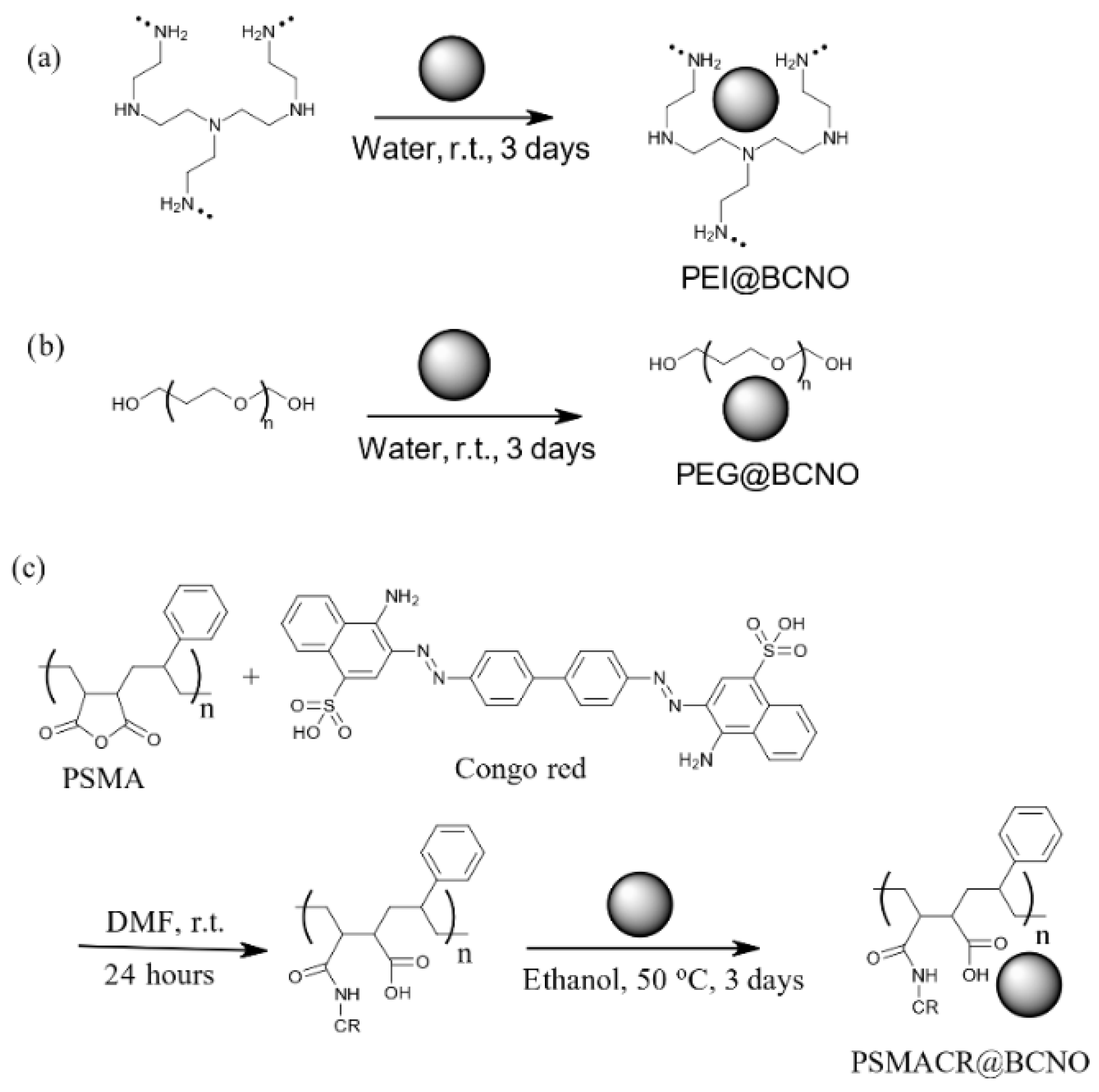
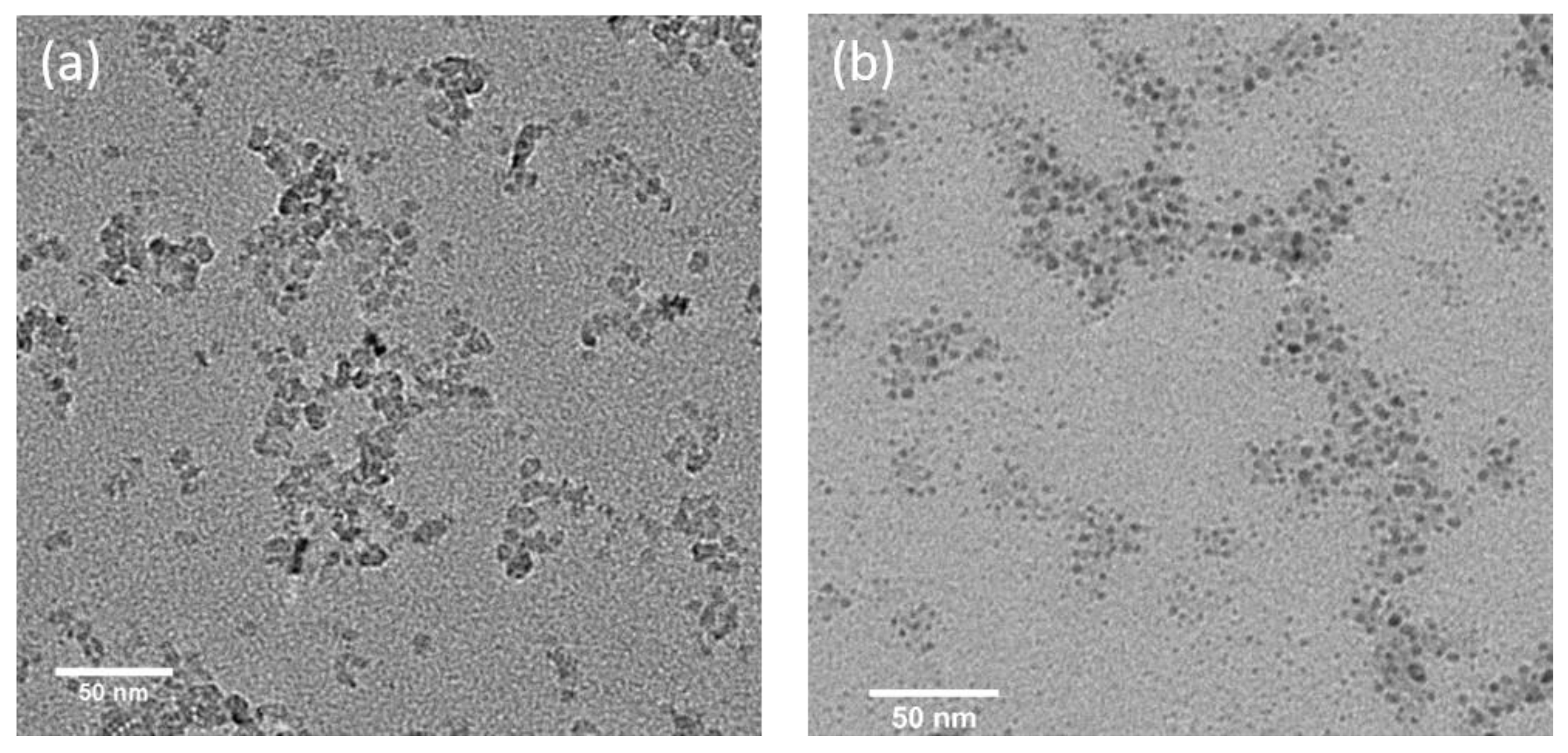
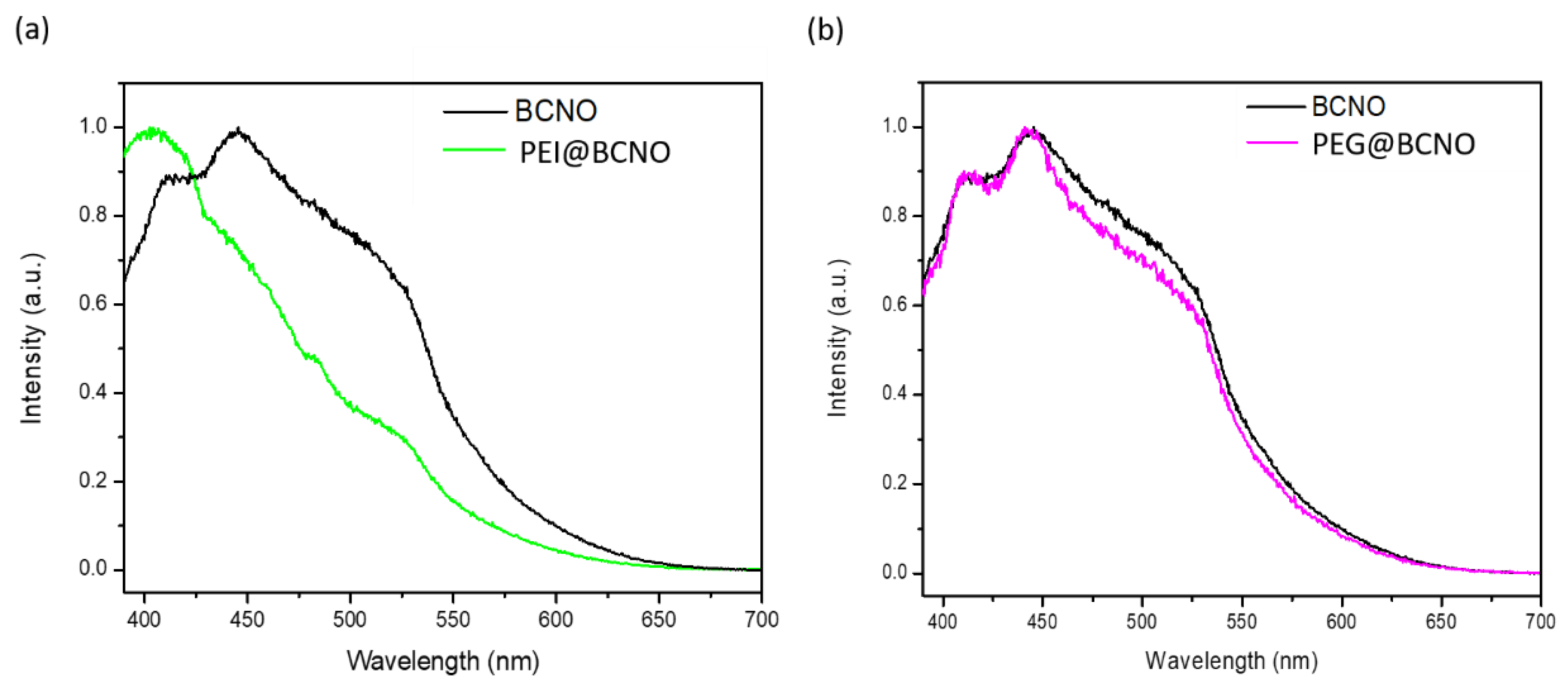

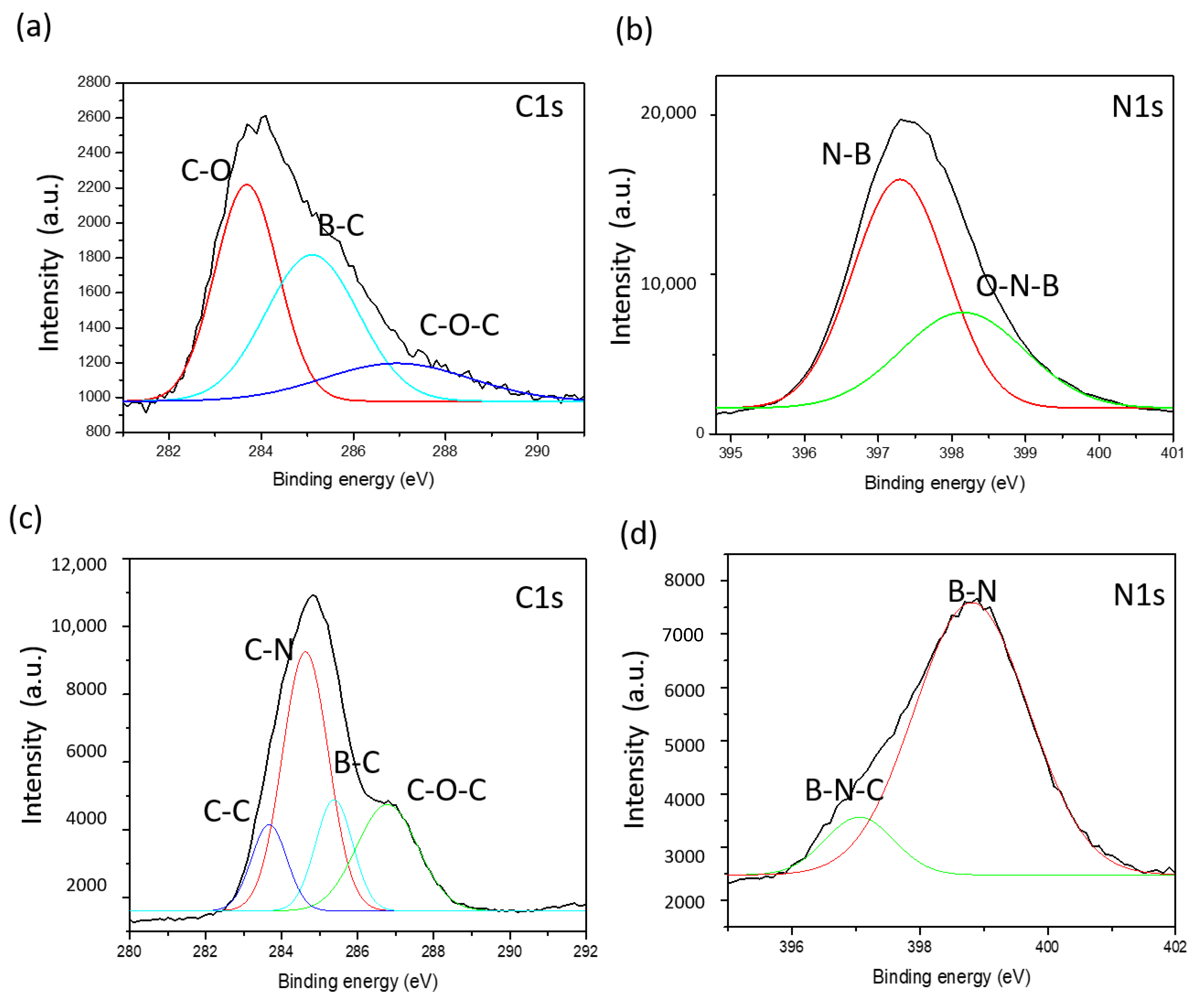

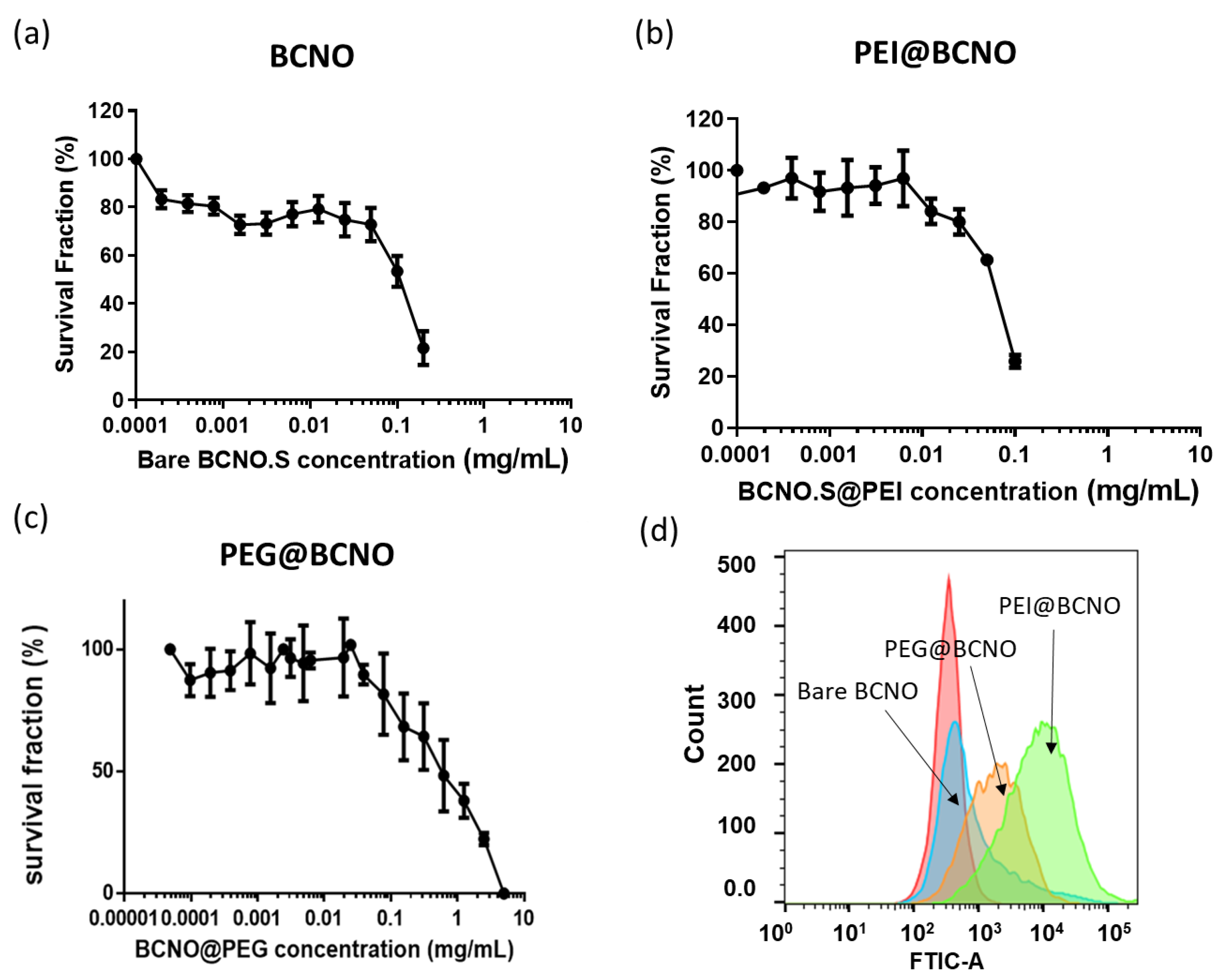
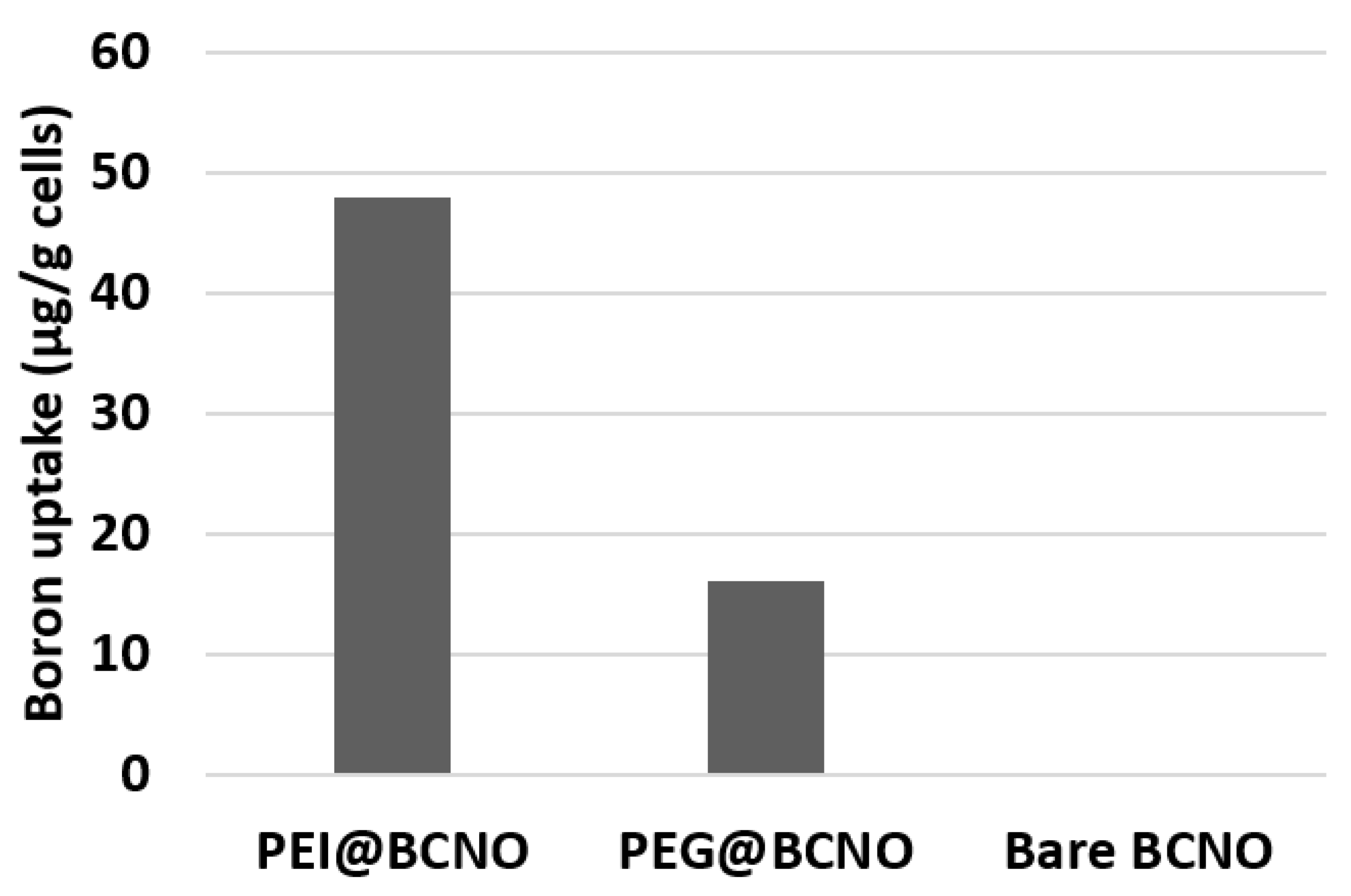

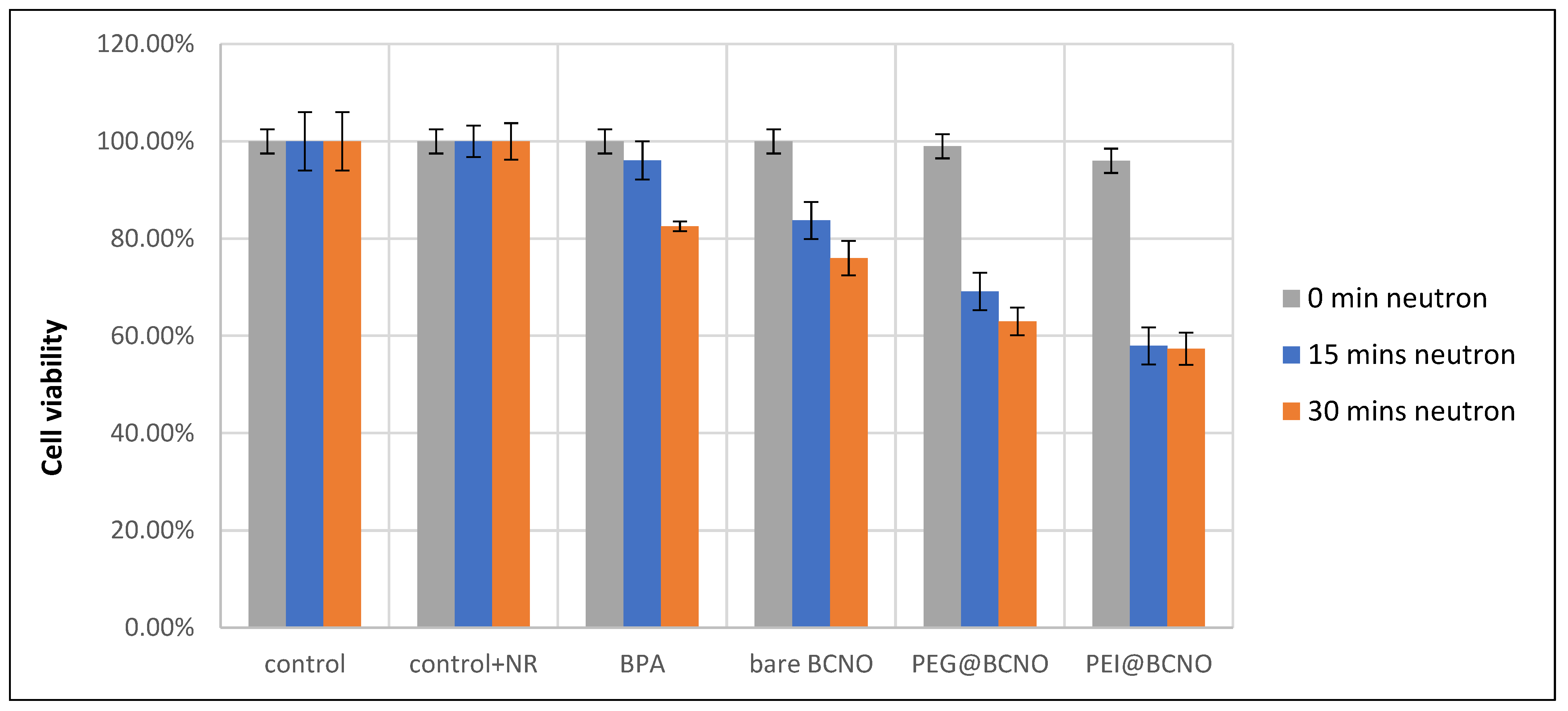
| Sample | B | C | N | O |
|---|---|---|---|---|
| BCNO | 40.6% | 7.6% | 36.3% | 15.5% |
| PEI@BCNO | 3.4% | 54.9% | 25.8% | 16.8% |
Publisher’s Note: MDPI stays neutral with regard to jurisdictional claims in published maps and institutional affiliations. |
© 2021 by the authors. Licensee MDPI, Basel, Switzerland. This article is an open access article distributed under the terms and conditions of the Creative Commons Attribution (CC BY) license (https://creativecommons.org/licenses/by/4.0/).
Share and Cite
Chiang, C.-W.; Chien, Y.-C.; Yu, W.-J.; Ho, C.-Y.; Wang, C.-Y.; Wang, T.-W.; Chiang, C.-S.; Keng, P.-Y. Polymer-Coated Nanoparticles for Therapeutic and Diagnostic Non-10B Enriched Polymer-Coated Boron Carbon Oxynitride (BCNO) Nanoparticles as Potent BNCT Drug. Nanomaterials 2021, 11, 2936. https://doi.org/10.3390/nano11112936
Chiang C-W, Chien Y-C, Yu W-J, Ho C-Y, Wang C-Y, Wang T-W, Chiang C-S, Keng P-Y. Polymer-Coated Nanoparticles for Therapeutic and Diagnostic Non-10B Enriched Polymer-Coated Boron Carbon Oxynitride (BCNO) Nanoparticles as Potent BNCT Drug. Nanomaterials. 2021; 11(11):2936. https://doi.org/10.3390/nano11112936
Chicago/Turabian StyleChiang, Chen-Wei, Yun-Chen Chien, Wen-Jui Yu, Chia-Yu Ho, Chih-Yi Wang, Tzu-Wei Wang, Chi-Shiun Chiang, and Pei-Yuin Keng. 2021. "Polymer-Coated Nanoparticles for Therapeutic and Diagnostic Non-10B Enriched Polymer-Coated Boron Carbon Oxynitride (BCNO) Nanoparticles as Potent BNCT Drug" Nanomaterials 11, no. 11: 2936. https://doi.org/10.3390/nano11112936







